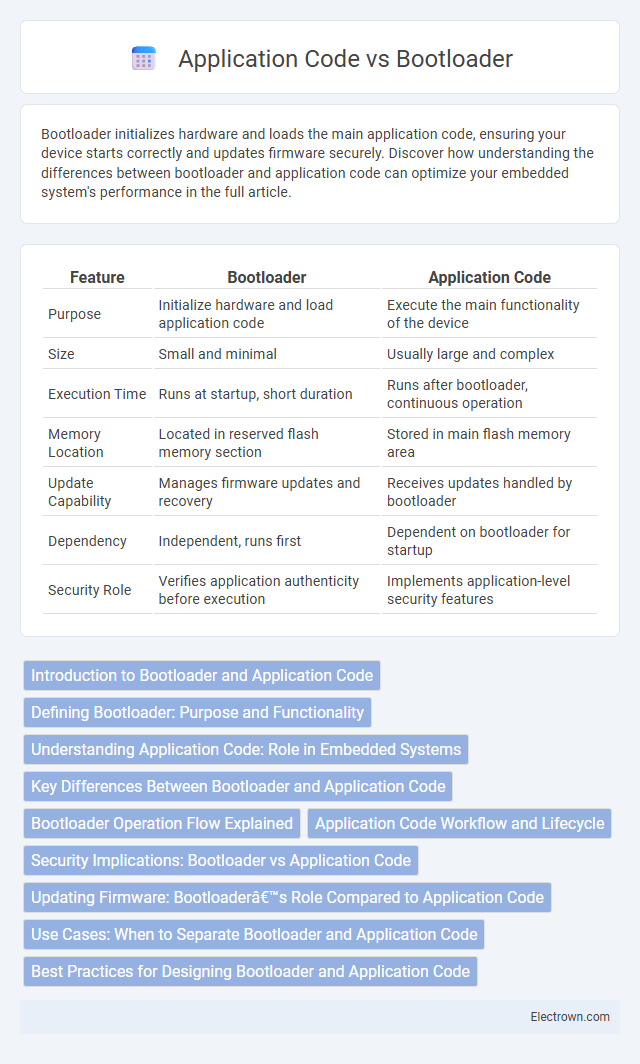Bootloader initializes hardware and loads the main application code, ensuring your device starts correctly and updates firmware securely. Discover how understanding the differences between bootloader and application code can optimize your embedded system's performance in the full article.
Table of Comparison
| Feature | Bootloader | Application Code |
|---|---|---|
| Purpose | Initialize hardware and load application code | Execute the main functionality of the device |
| Size | Small and minimal | Usually large and complex |
| Execution Time | Runs at startup, short duration | Runs after bootloader, continuous operation |
| Memory Location | Located in reserved flash memory section | Stored in main flash memory area |
| Update Capability | Manages firmware updates and recovery | Receives updates handled by bootloader |
| Dependency | Independent, runs first | Dependent on bootloader for startup |
| Security Role | Verifies application authenticity before execution | Implements application-level security features |
Introduction to Bootloader and Application Code
Bootloader is a small program that initializes hardware and loads the main application code into memory during device startup, ensuring a secure and reliable boot process. Application code contains the core functionality and logic of your software, executing tasks and interacting with hardware or peripherals after the bootloader completes its job. Efficient separation between bootloader and application code improves system stability, simplifies updates, and enhances device security.
Defining Bootloader: Purpose and Functionality
A bootloader is a specialized program that initializes hardware and loads the main application code when an embedded system powers on or resets. It serves as a critical interface between the device's firmware and the operating system, ensuring secure and reliable startup by managing tasks like memory checks, firmware updates, and system diagnostics. This functionality enables seamless application code execution, system recovery, and firmware upgrade processes without requiring external programming tools.
Understanding Application Code: Role in Embedded Systems
Application code in embedded systems serves as the core set of instructions that directly control hardware and perform specific functions tailored to user needs. It processes inputs, manages peripherals, and executes tasks critical for device operation, distinguishing itself from the bootloader, which primarily initializes hardware and loads the application code. Your embedded system's performance and functionality heavily rely on well-optimized application code to ensure efficient and reliable operation.
Key Differences Between Bootloader and Application Code
Bootloader is a small, specialized program that initializes hardware and loads the main application code during the device startup process. Application code contains the core functionality and logic that runs your device or software in its normal operating mode. Understanding the key differences between bootloader and application code helps optimize firmware updates, security measures, and system stability.
Bootloader Operation Flow Explained
The bootloader initiates the device startup by performing a hardware reset, verifying firmware integrity through checksum or cryptographic validation, and then deciding whether to load a new firmware image or jump to the existing application code. It manages memory allocation and hardware configuration necessary for safe and reliable application execution, often facilitating firmware upgrades via external interfaces like UART, USB, or CAN. This operation flow ensures secure, error-free transitions from the bootloader phase to the main application, critical for embedded systems stability and update management.
Application Code Workflow and Lifecycle
Application code workflow begins after the bootloader initializes the hardware and system resources, then transfers control to the main application. It manages tasks such as input processing, data handling, and output generation throughout its lifecycle, ensuring continuous operation and responsiveness. The application code lifecycle includes stages like initialization, execution, event handling, and eventual shutdown or reboot, often incorporating error handling and updates to maintain system stability.
Security Implications: Bootloader vs Application Code
The bootloader serves as the initial code responsible for securely verifying and loading the application code, making its security critical to prevent unauthorized firmware execution and potential system compromise. Application code runs after the bootloader and, while it controls device functionality, relies on the bootloader's integrity to ensure a trusted execution environment. Securing the bootloader with cryptographic checks and protected memory regions minimizes risks such as firmware tampering and unauthorized code injection, which are less effectively mitigated if security is only enforced at the application code level.
Updating Firmware: Bootloader’s Role Compared to Application Code
The bootloader plays a critical role in updating firmware by managing the initial loading and verification of new software before transferring control to the application code. Unlike application code, which focuses on executing the primary functions of the device, the bootloader ensures secure and reliable firmware updates, often including error checking and rollback mechanisms. This separation enhances device stability during updates and prevents corruption that could render the device inoperable.
Use Cases: When to Separate Bootloader and Application Code
Separating bootloader and application code is essential in embedded systems requiring firmware updates or secure boot processes, ensuring reliable firmware integrity and system recovery. When your project involves over-the-air (OTA) updates, dual-bank memory management, or complex device initialization tasks, a distinct bootloader facilitates seamless application upgrades without risking system failure. This separation optimizes memory usage by isolating critical startup operations from the main application logic, enhancing system stability and maintainability.
Best Practices for Designing Bootloader and Application Code
Designing bootloader and application code requires clear separation of responsibilities to enhance system reliability and maintainability. Ensure the bootloader handles hardware initialization, security checks, and firmware updates, while the application code focuses on core functionality and user interactions. Your design should include secure communication between the bootloader and application, with careful memory management to prevent overlap and data corruption.
Bootloader vs Application Code Infographic

 electrown.com
electrown.com